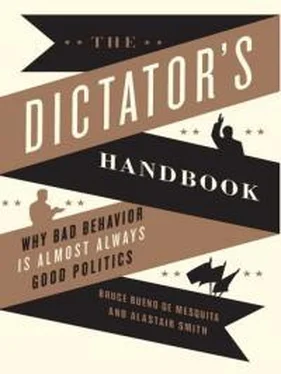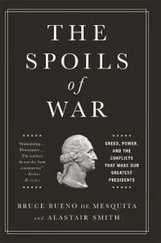To achieve power means recognizing the moment of opportunity, moving fast, and moving decisively to seize the day. And, for good measure, coming to power also means seizing any opponents, figuratively in democracies, and physically in dictatorships. Coming to power is not for the faint of heart.
Politics, however, does not end with becoming a leader. Even as you take up the reins of power and enjoy its rewards, others are gunning for you. They want the same job that you so desperately sought! Politics is a risky business. As we will see, successful leaders manage these risks by locking in a loyal coalition. Those who fail at this first task open the door for someone else to overthrow them.
3
Staying in Power
AT LONG LAST, THE ASPIRANT TO HIGH OFFICE HAS triumphed. Whether through inheritance, coup, election, revolt, murder, or mayhem, he has seized power. Now he faces a new challenge: hanging on to it.
As Sergeant Doe’s brutal career has taught us, rising to a high position often requires skills altogether different from those needed to maintain control. And even the rules for surviving in power do not always resemble the skills necessary for ruling well . The novelist Italo Calvino has clearly and succinctly described the tribulations of those who have risen to power: “The throne, once you have been crowned, is where you had best remain seated, without moving, day and night. All your previous life has been only a waiting to become king; now you are king; you have only to reign. And what is reigning if not this long wait? Waiting for the moment when you will be deposed, when you will have to take leave of the throne, the scepter, the crown, and your head.”1
What, then, must a newly minted leader do to keep his (or her) head? A good starting place is to shore up the coalition of supporters. This may seem like a simple enough task. After all, as we’ve seen, the heights of power are unattainable without the backing of a coalition strong enough to beat back rivals. However, a wise leader does not count too much on those who helped her gain power. Remember the fate of many of Fidel Castro’s closest allies. After toppling the previous leader, it’s only a matter of time until they realize that they can do the same again.
A prudent new incumbent will act swiftly to get some of them out of the way and bring in others whose interests more strongly assure their future loyalty. Only after sacking, shuffling, and shrinking their particular set of essentials can a leader’s future tenure be assured.
Nor is this only true of dictators. To see this urge to build a modified coalition at work in the seemingly less ferocious world of business, let’s take a look at Carly Fiorina’s rise and fall as CEO at Hewlett-Packard.
Governance in Pursuit of Heads
CEOs, just like national leaders, are susceptible to removal. Being vulnerable to a coup, they need to modify the corporate coalition (usually the board of directors and senior management), bringing in loyalists and getting rid of potential troublemakers. Usually, they have a large potential pool of people to draw from and prior experience to help guide their choices. But, also like national leaders, they face resistance from some members of their inherited coalition and that may be hard to overcome.
Most publicly traded corporations have millions of interchangeables (their shareholders), a considerably smaller set of influentials (big individual shareholders and institutional shareholders), and a small group of essentials, often not more than ten to fifteen people. In a group of this size, even seemingly minor variations in the number of coalition members can have profound consequences for how a company is run. As we will see, this was particularly true for Hewlett-Packard (HP), because, as in all companies, small shifts in coalition numbers can lead to large percentage changes in the expected mix of corporate rewards.
In the case of HP, the CEO’s winning coalition made up a relatively large fraction of the real selectorate because ownership is heavily concentrated in a few hands. That is, we might count corporate coalition size in terms of the number of its members or in terms of the number of shares owned by them. In HP’s case, the essential bloc and the influential bloc are a tiny part of the total selectorate because the families of the company’s founders, William Hewlett and David Packard, retain significant ownership just as was true of the Ford Motor Company, Hallmark Cards, and quite a few other businesses for many years.
Involvement in a corporation can yield benefits, just like any other form of government. These benefits can take the form of rewards given to everyone or private payments directed just to the essentials. In a corporate setting, private benefits typically come as personal compensation in the form of salary, perks, and stock options. Rewards to everyone—what economists call “public goods”—take the shape of dividends (an equal amount per share) and increased stock value. When the winning coalition is sufficiently large that private rewards are an inefficient mechanism for the CEO to buy the loyalty of essentials, public goods tend to be the benefit of choice. Usually, coalition members are eager to receive private benefits. However, dividends and growth in share value are preferred over private rewards by very large shareholders who happen also to be in the winning coalition—this would make them the biggest recipients of the rewards that go to all shareholders. That was precisely the situation in HP, where the Hewlett and Packard families owned a substantial percentage of the company.
Who makes up the essentials in a corporation? The coalition typically includes no more than a few people in senior management and the members of the board of directors. These directors are drawn from a mix of senior management in the company, large institutional shareholders, handpicked friends and relatives of the CEO (generally described as civic leaders , no doubt), and the CEO herself. In the parlance of economists who study corporations, the makeup of these boards boils down to insiders (employees), grey members (friends, relatives), and outsiders. One part of any corporate board’s duties is to appoint, retain, or remove CEOs. Generally CEOs keep their job for a long time and that certainly was true of HP’s first CEO, founder David Packard. He was replaced in 1992 by an insider, Lewis Platt, who had worked for the firm since the 1960s. Platt retired in 1999 and was replaced by outsider Carly Fiorina. The HP board has repeatedly deposed CEOs since then.
It should be obvious that any board members involved in deposing the former CEO have the potential to be a problem for a new CEO. Having once been a coup maker, there is little reason to doubt that they stand ready to start trouble once again if they think the circumstances warrant it. And what could those circumstances be but application of one or more of the rules of governance we set out earlier, especially if that application harms their interests.
Research into CEO longevity teaches us, not surprisingly, that time in office lengthens as one maintains close personal ties to members of the board. Just as sons and daughters may make attractive inheritors of the mantle of power in a dictatorship, friends, relatives, and fellow employees can generate the expectation of more loyal supporters after power is achieved. This logic probably contributed to Lewis Platt’s elevation to CEO of HP. Putting more outsiders on a board translates on average into better returns for shareholders, a benefit to everyone. At the same time, it also translates into greater risk for the CEO.2 Since the CEO’s interest is rarely the same as the shareholder’s interest, CEOs prefer to avoid outsider board members if they can.
Corporate problems, especially those serious enough to oust a sitting CEO, can serve to galvanize attention and enhance oversight by the board, making existing coalitions less reliable. Furthermore it is likely that the new, replacement CEO will face real impediments to his efforts to create and shape a board of directors in the wake of an older CEO’s deposition. After all, the old board members did not get rid of the prior incumbent with the idea that they would also make it easy for the successor CEO to get rid of them. Nevertheless, any new CEO worth her salt will try to do just that. The long-lasting CEOs are the ones who succeed.
Читать дальше












